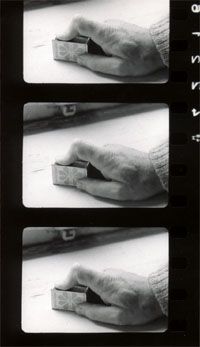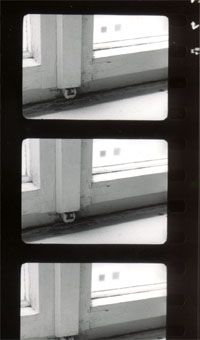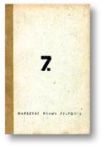|
|
MATCH BOX
35 mm film-5 min. 1975
Its basic assumption: film as a technique objectively relates what has happened.
The subject-matter of the audio-visual action in the film is a matchbox being tapped on the window-sill. The incident (both the picture and the sound) is being mechanically repeated.
The repeatable section of the picture consists of two takes:
1. A hand tapping a matchbox on the window-sill with the tap itself coming right in the middle of the take (90 frames).
2. An incomplete view of the window (30 frames)
The repeatable section of the picture (take 1+2) remains costant and lasts for 5 seconds (120 frames).
The repeatble stretch of sound, in which apart from the tap there is silence, is 5,O833 second long (122 frames). With each repetition of the action the sound falls behind the picture by another 0,083 seconds. This means that if in the first audio-visual variant the tapping is synchronous, the next synchronous tap will occur in variant 61.
We are dealing then with a film consisting of 60 different happenings, each and every one of them being the VERY SAME tap of a matchbox on the window-sill.
---------
A closer look at the mechanism of the perception of the film has revealed that the chain of happenings can be safely divided into 3 sections : A1, A2 and B.
The events in section A1 and section A2 are 'easily absorbed'. It is so because they can be compared with real life experience. The most vivid correlation with this experience can be observed in section A1, that is, in the case of total synchrony of the tap with both the sound and the picture. Experience has proved that not one but several audio-visual variants are perceived as synchronous. The A1 section gets slightly prolonged by asynchrony perceived as either echo or sound delay due to the length of the distance between the observer and the actual scene of the happening. These arguments are dictated by the unquestionable and logical connection between the cause and the effect.
The A2 section is on the other hand more ambivalent, although it also 'appears in reality'. It becomes evident in those parts of the film in which the sound of the tap accompanies something different in the picture (the window), something from 'outside the frame'. The 'easy absorbtion' of the A2 is caused not so much by common sense as by the 'cultural heritage' (see: creative asynchrony, Eisenstein, etc.).
Although, however, we have managed to get used to the sound from ouside the frame, the complete silence which accompanies the image of the matchbox being tapped on the window-sill in section A2 creates something of a dissonance.
The audio-visual events in section B are 'harder to absorb', for they negate life experience and rarely refer to the 'cultural heritage'. In this particular section the effect comes before the cause, or is so far away that it does indeed lose its touch with it. In a commercial film a type B happening may appear as a comic effect or a technical error. The latter, by the way, explains the most and is obvious.
What still needs explaining is the issue of boundaries between the above-mentioned sections. The A1 has its origins in the 'first' synchronous moment. Its end, however, is more disputable. The impression that the sound still is or isn't interconnected with the picture cannot be different for different people. I take, therefore, a half-a-second delay as the end of section A1.
Section A2 (the sound outside the frame) can be easily defined, whereas the remaining parts of the film constitute section B. I need to establish those boundaries solely in order to signal changeable, favourable and
unfavourable attitude of the viewer towards the happening being presented. Those boundaries, in fact, cannot possibly be viewed as a point. (...)
---------
The division into section A and section B is by all means artificial and has been introduced from outside, as a result of the analysis of the public's perception of the film and concerns only the perception itself and not what is actually happening in it. What 'exists' and what 'does not exist' in a film is our mind's projection. Our consciousness, under the pressure of what we commonly call culture, becomes liable to those abrupt swings while everything in the film 'is' right there, unwavering.
In its principle this film assumes equality of all the audio-visual variants. This equality, in turn, assumes the impossible possible, yet most importantly it questions the apparently obvious connection between the audio and the visual aspects of absolutely real
happenings.
| |






Article taken from '7'
published by
the 'Workshop Group' in 1975
|